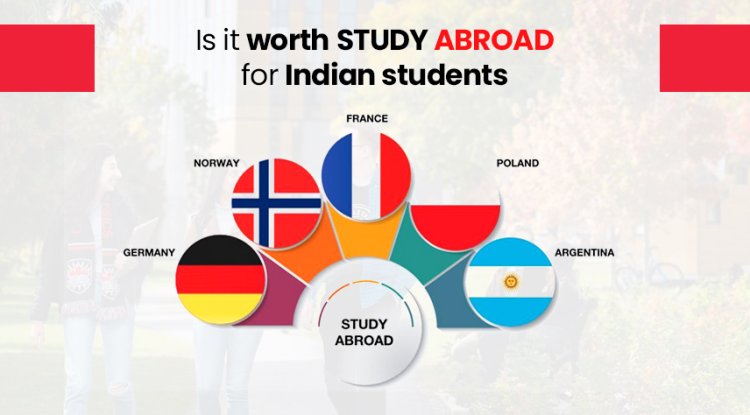Difference Between Public And Private Universities In The US
Public and private universities in the United States differ in several key aspects, including their funding sources, ownership, size, cost, admissions process, and overall atmosphere. Here's a breakdown of the main differences between the two types of universities:

Choosing between a public and private university in the United States is a critical decision for international students, particularly those from India looking for the best study abroad possibilities. Public colleges are noted for their broader size and affordability, as opposed to smaller, more expensive private university that offer specialized attention and ample resources. This decision, however, is dependent on a student's specific needs and preferences. While both public and private university in the United States provide excellent education and diverse student communities, Indian students must carefully consider prices, location, academic offerings, and campus culture. In this blog, we will compare and contrast public and private US universities to help Indian students make an informed decision about their higher education journey.
Exploring The Public University Experience
Public universities, which are frequently supported by state governments, accept a large number of students looking for a low-cost education. Because of their larger size and resources, they provide a diverse range of academic programs and research possibilities. Indian students frequently discover a plethora of majors and emphases that suit their preferences. With a varied student body that represents a wide range of cultures and backgrounds, public colleges provide an immersive experience that promotes global understanding.
While tuition at public universities is typically lower for in-state residents, international students may find them to be more affordable than private universities. However, negotiating these fees necessitates a thorough examination of out-of-state tuition rates and scholarship alternatives.
Delving Into The Private University Advantage
Private universities, while more expensive, provide a more intimate environment and luxurious resources, which often translate into a more individualized education. Smaller class numbers allow for more meaningful interactions between students and teachers, fostering an environment conducive to intellectual exploration and personal growth. Private universities may be a good fit for Indian students looking for a caring academic environment and a close-knit community.
These colleges frequently provide unique programs and cutting-edge research possibilities in specialized fields of study. Higher tuition rates are mitigated by financial aid and scholarship opportunities, which can greatly reduce the financial burden for meritorious students.
Factors to Consider
- Tuition and Financial Aid: While public universities often have cheaper tuition prices, private universities frequently provide large financial aid packages to offset greater costs.
- Location and Campus Culture: The university's location might have an impact on the whole experience. Public universities may be found in lively cities, whereas private universities may be found in peaceful suburbs.
- Class Size and Interaction: Smaller class sizes are common at private universities, allowing for more engaging interactions between students and faculty.
- Academic Programs: Academic programs and research opportunities vary between public and private universities, determining your academic path.
- Resources and Facilities: Private universities have more modern facilities and resources that contribute to a well-rounded learning experience.
Public or Private Universities in the US? Know the difference.
Choosing the right college for higher education in the United States might be difficult. When choosing a university in the United States, numerous criteria such as funding, campus size, and offered disciplines of study must be considered. To help with this decision, it's useful to grasp the distinction between public and private universities. Here's a quick rundown of both types of universities.
Public Universities: Affordable and Diverse
State governments support public universities in the United States, which generally results in lower tuition prices, particularly for in-state residents. These colleges often have a larger student body and provide a diverse choice of academic programs and majors. The diversity of students and cultures at public universities is an important feature that develops global understanding and cross-cultural relationships.
Furthermore, because of their bigger size and funding, public universities frequently feature significant research opportunities and comprehensive facilities. They can be found in urban or rural places, and offer a range of settings to suit diverse tastes.
However, for overseas students, tuition fees may fluctuate between in-state and out-of-state inhabitants. Scholarships and financial aid are available to help offset the cost gap.
Private Universities: Personalized Attention and Resources
Private universities, on the other hand, are supported by tuition, donations, and endowments. Smaller class numbers at these colleges allow for more personalized attention from teachers and build close-knit student groups. Private universities' academic programs might be one-of-a-kind and tailored to certain fields of study.
While private universities are frequently more expensive, they also provide more significant financial aid and scholarship possibilities. This can make them more accessible to students who may not have considered a private school because of the cost.
Private universities are well-known for their cutting-edge research opportunities and strong emphasis on student support services. The campus climate is more intimate and concentrated, allowing students to build deep bonds with their peers and staff members.
Public Universities in the US
Public universities, often known as state universities, are universities of higher learning that receive public support from the state government. This financing is critical in improving these universities' infrastructure and educational programs, ultimately benefiting both the universities and their students. Here are some of the best public colleges in the United States that have been recognized for academic achievement and contributions to higher education:
- University of California, Los Angeles (UCLA): UCLA is well-known for its broad academic programs, cutting-edge research, and dynamic campus culture.
- University of Michigan, Ann Arbor: With a rich history and a dedication to innovation, the University of Michigan provides a diverse range of academic possibilities and is well-known for its strong emphasis on research.
- North Carolina State University, Chapel Hill: UNC Chapel Hill is known for its outstanding academic reputation, historic campus, and dedication to community participation as the country's oldest public institution.
- University of Virginia: Founded by Thomas Jefferson, the University of Virginia is known for its Jeffersonian architecture and challenging academic programs.
- University of California, Berkeley: UC Berkeley, located in the San Francisco Bay Area, is well-known for its breakthrough research and contributions to a variety of subjects.
- University of Wisconsin-Madison: Known for its research projects and dynamic student life, the University of Wisconsin-Madison provides a diverse choice of programs in a friendly environment.
- University of Illinois, Urbana-Champaign (UIUC): With a concentration on innovation and research, UIUC is a technical and academic powerhouse.
- College of William and Mary: As one of the country's oldest universities, the College of William and Mary takes pride in its outstanding liberal arts education and historic significance.
- The University of Texas at Austin is well-known for its varied student body, wide academic programs, and thriving arts scene.
- Georgia Institute of Technology: Also known as Georgia Tech, this university is renowned for its education and research in science, technology, engineering, and mathematics (STEM).
These public colleges have continually proved their dedication to offering high-quality education, encouraging innovation, and giving back to their communities and beyond. They provide a variety of academic programs, cutting-edge facilities, and chances for students to participate in research, extracurricular activities, and personal development. As overseas students consider their options for higher education in the United States, these top-ranked public colleges stand out as schools that provide a balance of academic brilliance and a welcoming environment for learning and growth.Top of Form
Private Universities in the US
Private universities in the United States, as opposed to public universities, do not receive government funding and instead rely on student contributions, donations from benefactors, and private sources to fund their operations and educational programs. Despite their autonomous funding arrangement, these universities are frequently ranked among the world's most prestigious and esteemed schools. Here is a list of some of the best private universities in the United States, with a track record of success in education, research, and general academic standing:
- Harvard University: Known for its historic past, Harvard routinely ranks among the best universities in the world, offering a varied range of academic programs and great faculty expertise.
- Stanford University: Stanford University, located in the heart of Silicon Valley, is known for its creativity, research contributions, and active campus environment.
- Princeton University: Princeton is a close-knit intellectual community with a beautiful campus that focuses on undergraduate education and serious research.
- Massachusetts Institute of Technology (MIT): MIT is well-known for its competence in science, engineering, and technology, and it serves as a centre for ground-breaking research and innovation.
- California Institute of Technology (Caltech): Caltech specializes in science and engineering, with a collaborative environment and a dedication to cutting-edge research.
- Yale University: Yale University, known for its full liberal arts education, has a rich history, diversified academic departments, and a dynamic campus culture.
- Duke University: Duke distinguishes out for its world-class programs and lively community, with a strong emphasis on interdisciplinary teaching and research.
- Columbia University: Located in New York City, Columbia University offers a varied range of academic subjects and benefits from the opportunities provided by its urban location.
- Johns Hopkins University: Known for its medical and research programs, Johns Hopkins provides a diverse range of academic disciplines as well as a reputation for innovation.
- Northwestern University: With a focus on research and a varied range of academic offerings, Northwestern offers a well-rounded education in a diverse and collaborative setting.
These private universities are known for their commitment to academic excellence, cutting-edge research, and contributions to a variety of sectors. Students at these universities benefit from resources, faculty expertise, and a network of peers that promotes their personal and professional development. While tuition at private universities is often costlier, they frequently offer considerable financial aid packages to worthy students, making them highly sought-after destinations for those wanting a world-class education.
Public vs. Private Universities – Understanding their core differences
Public Universities:
- Funding: Government and other sources, including tuition fees, provide funding.
- Tuition Costs: Generally, tuition fees are lower, especially for in-state students.
- Student Body: A larger student body with a diverse demographic.
- Program Range: A wide variety of programs and courses are available.
- Research Opportunities: More research opportunities and resources may be available.
Class sizes result in less individual attention. - Campus Atmosphere: Campuses may be more dispersed, with a possibly diminished sense of community.
- Decision Making: Bureaucratic procedures with the potential for further red tape.
Private Universities:
- Funding: Tuition, donations, and some government support are the primary sources of funding.
- Tuition cost: Tuition is often expensive, but financial help and scholarships are frequently available.
- Student Body: A more homogeneous student population with a smaller student body.
- Program Range: There may be a restricted number of programs available, with a focus on specific fields.
- Research Opportunities: More individualized attention, lower class sizes, and broader faculty access may be available.
- Smaller class sizes allow for greater interaction with instructors.
- Campus Atmosphere: A small, personal college atmosphere.
- Decision Making: Decision-making methods that are faster and more efficient.
Finally, the decision between public and private universities is influenced by personal tastes, ambitions, and circumstances. Some students may thrive in a public university's dynamic environment, whilst others may prefer the particular attention and close-knit community of a private college. When making such a big decision, factors such as program offerings, financial considerations, campus culture, and academic objectives should all be carefully considered. Whether you choose to be a part of a larger and more diverse community or a more intimate educational experience, both types of universities provide distinct chances for growth and learning.
Public vs. Private University: Which is the right choice for you?
Choosing between a public or private institution is a vital step in your educational path, and it's critical to match your tastes, needs, and academic goals. Consider the following elements to help you make an informed decision:
1. Cost of Attendance:
Public colleges, which are sponsored by the government, often have cheaper tuition prices; private universities, on the other hand, may have higher tuition expenses, but they frequently offer scholarships and financial aid to lessen the financial load.
2. Quality of Education:
While both public and private colleges provide high-quality education, their approaches and emphasis on specific areas, such as hands-on learning or research, can differ.
3. Range of Programs and Majors:
Private universities may offer specialized academic programs, whereas public universities often provide a broader range of courses and degrees.
4. Student Diversity:
Private universities frequently have a varied student population, bringing people from all backgrounds together. Public universities may attract a more local student body, resulting in a distinct type of diversity.
5. Campus Atmosphere:
Because public universities have larger campuses and student bodies, the atmosphere is more expansive but perhaps less intimate. Private universities have smaller class numbers and a close-knit community, which promotes closer relationships between students and teachers.
6. Career Opportunities:
Both types of universities offer excellent employment resources, but the details may differ. Investigate the internship programs, networking events, and alumni connections that each provides.
7. Location:
Because public universities are frequently located in metropolitan locations, they may give greater transportation alternatives and city life experiences. Private universities often have campuses in more rural areas, providing a more calm and concentrated environment.
You can confidently choose whether a public or private institution corresponds better with your goals by carefully analyzing these variables and thinking on your specific needs, ambitions, and preferences. Remember that there is no one-size-fits-all solution; what matters most is finding an educational environment that resonates with your goals and provides the support you require to succeed. Your decision today will influence your destiny tomorrow.
Conclusion
The decision of whether to attend a public or private institution in the United States is a critical one that will affect your educational career and future. This decision is especially important for international students, including those from India, who are looking for the greatest study abroad possibilities. Both sorts of universities have various benefits and considerations, so it is critical to assess these elements against your particular tastes and objectives.
With their larger size and lower tuition prices, public universities provide a varied selection of academic programs as well as a thriving student community. They are frequently supported by state governments, making education more affordable to in-state people. International students, on the other hand, should be aware of potential tuition differences between in-state and out-of-state citizens.
Private universities, on the other hand, provide an intimate and close-knit environment with specialized attention and vast resources, despite their higher tuition fees. They frequently excel in specialized fields of study, and their significant financial assistance packages can help alleviate financial burdens.
Cost, academic programs, class sizes, campus atmosphere, and job options are all important considerations in the decision-making process. Furthermore, your selected college location, whether urban or rural, influences your whole experience.
By carefully weighing these factors against your specific requirements and goals, you may confidently select whether a public or private university is best for you. Recognize that this decision is about more than just schooling; it is also about the atmosphere that fosters your growth, learning, and future success. The educational path you choose today will pave the road for a bright future, ensuring that your further education journey is in sync with your aspirations and talents.
What's Your Reaction?





















